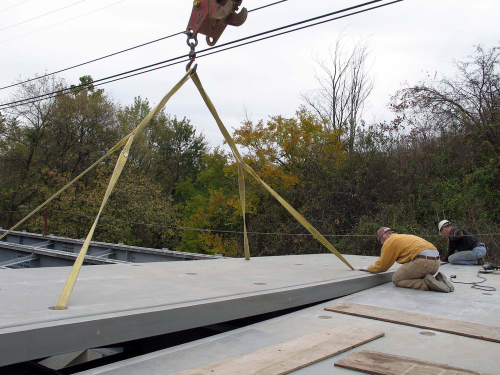
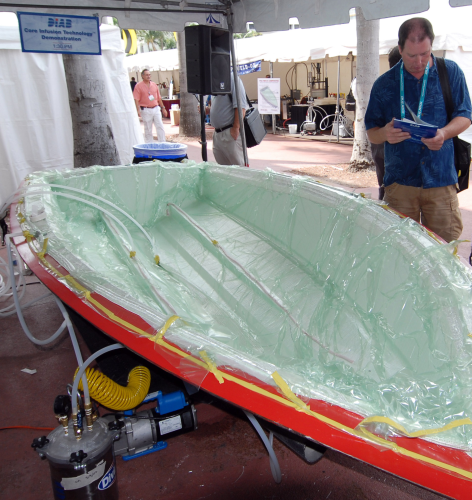
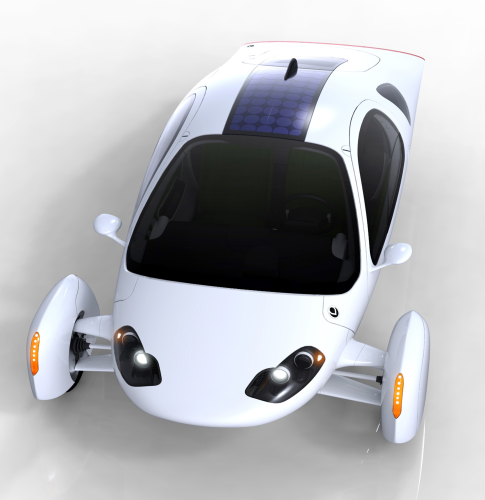
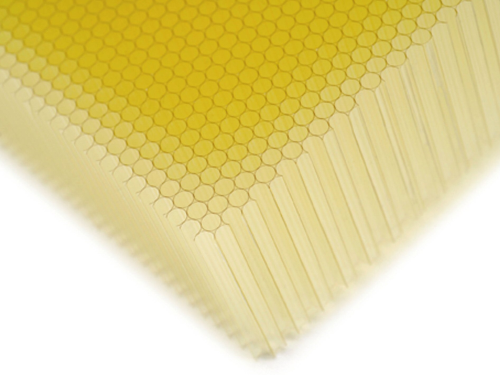
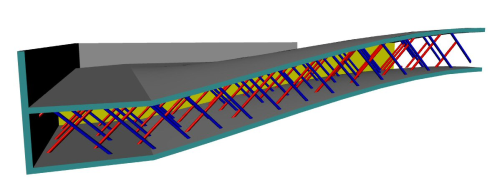

Low density core materials are utilised both in open mould and closed mould processes to produce lightweight, high strength, cost effective composite sandwich structures for applications in a wide range of industries, most notably aerospace, defence, marine, transportation and construction. A composite sandwich structure utilises two skins or facings bonded to a core material such as closed-cell foam, balsa wood or honeycomb.
The core increases the section modulus of a laminated composite structure, providing added stiffness and strength. It distributes loads and stresses and resists shear and compressive forces.
Many skin and core combinations are available to meet end-user requirements. Honeycomb core made from phenolic resin-coated kraft paper or cardboard is frequently used for cost-sensitive applications. Structural honeycomb of extruded polypropylene is tough and moisture-resistant. End-grain balsa wood is favoured for its high compressive strength, fatigue resistance and low cost. Foam core products made from various polymers are designed to provide specific performance qualities.
Cored composite specialist
CATTCO USA, a manufacturer of composite sandwich panels in Cattaraugus, New York, USA, employs a broad range of cores and skin materials, helping customers specify the right combination for their applications. A workforce of up to 80 people produces panels for the transportation, marine, architecture, industrial and commercial markets.
Wayne Johnston, sales manager, relates that customers often rely on the company’s experience to ensure that the panels they order meet their performance requirements and fit within their cost structure.
“It’s easy to tell someone he needs a Nomex-cored panel with stainless skins,” says Johnston, “but why use a US$500 panel when a $200 one is fine for their needs?”
Customers are asked how the panel will be used, whether it will be outside, exposed to salt air or chemicals, any special fire safety considerations, load requirements. The use of fasteners is also a consideration. Internal blocking and tap plates can be added to secure fasteners, he notes.
Johnston sees a trend toward the increased use of structural foam core materials.
“More people are looking at foam as an option in sandwich composites because of the advantages it offers – good compressive strength, uniform bonding surface, and good burn characteristics,” he relates.
Foam products provide outstanding impact strength; fire, chemical and fatigue resistance; heat tolerance; and other desirable qualities. End-grain balsa is also popular, especially for wind turbine blades and marine applications, he adds.
Low density at low cost
Tricel Honeycomb Corp of Gurnee, Illinois, USA, produces kraft paper honeycomb fabricated in a continuous series of triangular cells, a design which provides outstanding strength and rigidity at low cost – the most economical strength-to-weight ratio available, says Tricel. A wide range of specifications are available, including basis weight of paper, honeycomb thickness, cell size, and resin content.
Tricel honeycomb is used extensively in the USA in sandwich construction of pickup truck caps and automotive applications.
The load floor of the Volkswagen Tiguan is made of a lightweight but very strong and rigid composite structure manufactured with a cardboard honeycomb core and the Baypreg® F polyurethane spray system from Bayer MaterialScience (BMS). The core material is covered by an outer layer of glass fibre mats, and the sandwich is sprayed on both sides with the liquid Baypreg F reaction mixture. The structure is then inserted into a heated mould and compression moulded at approximately 130°C. The application of heat triggers the reaction of the two-component polyurethane system.
The load floor, introduced last year and continued in the 2009 Tiguan, weighs less than 3 kg/m2 and is up to 80% lighter than corresponding components made of conventional materials, such as wood or sheet metal, reports BMS.
Paper honeycomb and Baypreg F are also used in a roof module concept developed by BMW that can reduce weight by 25% compared with conventional roof modules made of steel. The core and glass fibre mat facing layers are sprayed with Baypreg F, with long chopped strands being additionally applied to the edges of the glass fibre mats during the spraying process. The package is compression moulded at 130-140°C, producing a lightweight roof module with the required high flexural stiffness.
Advancing honeycomb cores
Nida-Core Corp has developed a variety of materials for sandwich structures, including environmentally friendly products. One is a honeycomb core filled with soy-based foam designed for thermally efficient walls for refrigerated containers or trailers.
Nida-Core, based in Port Saint Lucie, Florida, USA, is best known for its structural honeycomb materials, such as H8PP, which is made of a proprietary polyurethane copolymer and covered on both faces with a soft, polyester, nonwoven fabric. Using complex processing techniques, the material is extruded to form hexagonal shapes, which are thermally fused together into blocks. The visco-elastic thermoplastic formulation provides excellent impact resistance, resilience and sound damping, the manufacturer relates. Hexagonal-shaped cells impart high compressive strength. Impact loads are dissipated by the elastic and damped response of the core in a controlled deflection with recovery, much like an automotive shock absorber, explains Nida-Core.
Structures made with this core are said to be less prone to catastrophic failure under impact than other core materials such as balsa and rigid foams, which produce a stiffer composite but without damping.
In addition to structural honeycombs, Nida-Core also produces other lines, including BalsaLite, a highly processed end-grain balsa noted for high resistance to crushing and its ability to handle excessive dynamic loads with superior resistance to fatigue.
In addition, the company produces FoamLine polyurethane foam, NidaFoam PET foam, and NidaFoam 3D structural plastic foam core. NidaFusion STO and STF lines are designed for use in resin transfer moulding (RTM) and other closed moulding processing. STO is a rigid, closed-cell foam with fibre reinforcement on both sides, stitched together with glass strands. The strands pass through obliquely to form triangulations for increased stiffness and stress under bending as well as much greater resistance to core shear and compression, notes Nida-Core. STF is a variation that is mounted on a flexible foam backing for pressure forming.
Nidaplast Composites of Thiant, France, produces a range of extruded polypropylene structural honeycombs, with or without flexible polyester nonwoven skins. Made with hexagonal cells, Nidaplast® 8 provides a low shear modulus and can withstand considerable deformation without breaking. If the composite experiences a high increase in load, the honeycomb will deform without the kind of catastrophic core rupture that occurs with some very rigid foam cores, the company observes. For infusion processing, Nidaplast 8RI is reinforced specifically to resist the pressure of resin on the core to keep the cells from filling. The 8RI panels can be perforated at 15 cm intervals.
Honeycomb core for FST
Polypropylene and polycarbonate are commonly used to produce honeycomb cores, but for many aerospace applications with stringent standards for flame, smoke and toxicity (FST), those polymers do not meet requirements. When Tubus Bauer GmbH, a German manufacturer of honeycomb core material, made a decision to expand into products for aircraft interior panels, an Ultem™ resin from SABIC Innovative Plastics was selected because of its inherent flame retardance, high strength and high stiffness, the company relates.
Ultem, an amorphous thermoplastic polyetherimide (PEI) resin, is extruded to produce hollow tubes. The tubes are cut to length and joined using a thermo-bonding process for adhesion, Sabic explains.
Tubus Bauer offers honeycombs based on a wide range of polymers to meet the mechanical, chemical and thermal demands of end users. By varying the polymer type, the wall thickness, or the density of the honeycombs, virtually any level of crush load can be achieved. The value for the load remains constant up to high deformations, the company notes.
SABIC also manufactures Ultem foam from Ultem resin at a 10-30 times density reduction as lightweight core material for composite sandwich structures.
The DIAB Group, based in Laholm, Sweden, manufactures a broad variety of structural polymer foam materials in the Divinycell range. The products offer high strength-to-weight ratios, excellent insulation properties, low water absorption and good chemical resistance. Various grades and densities are available to meet application specific requirements. Divinycell F polyether sulphone is a low FST/high-temperature foam core designed for aircraft and public transportation markets. DIAB also supplies ProBalsa end-grain balsa wood core.
Closed moulding cores
The Core Infusion Technology™ developed by DIAB is said to offer significant advantages over other closed mould vacuum infusion processes. The DIAB system is based on using gooved and perforated infusion core as the resin transfer medium. Well suited for boat building, the system is said to produce laminate quality that is much higher than open moulding and can cut mould cycle times by up to 50% and labour costs by 30% over conventional processing. According to DIAB, the specially grooved core enhances the structural performance of the composite and eliminates the need for sacrificial distribution mats or nets for a cost savings and waste reduction.
Three new products in DIAB’s structural polymer cores range were added this year. Ultra lightweight Divinycell H35, with a nominal density of 38 kg/m3, is being hailed by DIAB as the world’s lightest structural foam core. The company recommends the core for moderately loaded structures such as wind turbine nacelles and panels in motor homes and caravans. Also new are H160 and HP160, both with a density of 160 kg/m3. The HP variant is prepreg compatible, while the H grade is general-purpose core. Offering very good impact resistance and slamming behaviour, the material is well suited for use in hull bottoms of large boats, DIAB notes.
DIAB foam core plays an integral role the construction of an innovative facade of an office building in Copenhagen which was selected as a winner in the JEC Innovation Awards 2009. Skandinaviska Glassystem AB of Sweden developed the modular sytem that uses sandwich composites to hold glass and marble components instead of using a conventional steel latticework. The modules enable a fast installation by fewer workers since they were designed to be installed directly onto the building’s concrete floors. The composite system is said to provide superior insulation and water-resistant properties and does not rust or corrode.
Sandwich composites based on DIAB cores are used extensively in the bodywork of a three-wheel, all-electric vehicle produced by Aptera Motors Inc of Carlsbad, California, USA. Composites were employed to maximise the innovative vehicle’s strength-to-weight ratio and achieve its aerodynamic shape, the company relates.
Cores for resin infusion
Gurit AG, headquartered in Z?rich, Switzerland, is a leading global supplier of structual foam core material, including foams for infusion processing. The company’s Corecell™, based on styrene acrylonitrile (SAN) chemistry, is available in various grades to meet the performance needs of specific applications.
Corecell A-Foam, the original product, was developed as an alternative to polyvinyl chloride (PVC) core technology in marine sandwich structures. It offers high resistance to styrene and other chemicals as well as better thermal stability than linear PVC foam, relates Gurit. Highly thermoformable, it is available for use in every resin infusion format and is compatible with polyester, vinyl ester and epoxy resin systems.
Scott & Fyfe Composites Ltd (formerly Flemings Textiles Ltd), of Kilmarnock, Ayrshire, UK, designs and manufactures glass fabric reinforcements for the composites industry, including the Polymat® range of high-loft cores sandwiched and stitch-bonded between layers of glass reinforcement. Polymat is designed for use in RTM and other closed mould processes. Also available is Polymat Hi-Flow, which is designed to provide a path of low resistance to the resin for a uniform infusion with less opportunity for dry spots.
Plascore Inc of Zeeland, Michigan, USA, manufactures honeycomb cores and composite panels utilising a broad range of materials, including aramid, polycarbonate (PC), polypropylene (PP), and infusion-grade PP.
The infusion-grade honeycomb is designed for optimum performance in light resin transfer moulding (RTM) processing, notes Plascore. Low in density and very cost-effective, the material gives composite manufacturers the ability to deliver value-priced sandwich structures to customers who require high stiffness and light weight.
WebCore Technologies Inc of Miamisburg, Ohio, USA, designs, manufactures and sells engineered composite foam core products for demanding structural applications. The TYCOR® family of low-density core features through-thickness fibreglass webs and skin reinforcements on the surface of the core. Ideally suited for vacuum infusion processing, the core is said to offer a combination of high strength, stiffness and impact-damage tolerance.
The webs serve as structural elements and enhance resin flow during moulding, while the surface reinforcements greatly improve the skin-to-core bond strength and resistance to delamination, explains WebCore. The company has developed a spreadsheet-based analytical design tool that enables rapid evaluation of fibre architecture, material usage, weight, stiffness and strength estimates for TYCOR sandwich construction.
| Advanced Composite Structures (ACS), a New Mexico, USA, manufacturer of air cargo and baggage containers, has developed a product called the Aerobox using lightweight thermoplastic sandwich panels with a proprietary honeycomb core. The composite container overcomes the heavy weight and other drawbacks of conventional metal air cargo containers while providing increased robustness, improved repairability and reduced life-cycle costs, according to F. Truman Williams, VP and Chief Technology Officer. Williams discussed the design and production of the Aerobox, including the manufacture of the company’s own honeycomb core, at the Composites+Polycon 2009 Conference in Tampa, Florida, USA, in January. Initial operational tests conducted with 23 airlines with more than 400 Aerobox units on over 50 000 flight segments resulted in fewer than 50 required repairs reported, according to ACS. The company utilises cross-plied unidirectional tapes of E-glass and ultraviolet (UV)/heat stabilised polypropylene (PP) for the skin of the sandwich panels. A polypropylene copolymer selected for high stiffness is employed for the core material, which the company produces on premises, related Williams. The core is made up of extruded PP tubes or straws, which are extruded, coated with a polyolefinic adhesive film, and nested together in a hexagonal configuration. The stack is moved into an oven, where they are thermally fused together to form a block. The polyolefin melts at a lower temperature than the PP straws. The block of straws is then cooled and sliced into sheets to serve as the core of the sandwich panels. Consolidated skin material is fed from rolls into a laminator that applies the skins – heated to melt temperature – to the core sheets, which are also heated in the lamination process. Once cooled, the panels are sawn to length. The process allows melt fusion of the bond interface without the full melt of the skin material, Williams explains. Some sacrificial melt of the core produces a bond in the glass-rich skin. Skin doubler strips are added to the panel edges with ultrasonic spot welding, and the core and doubler are fused at the edge for added strength. The Aerobox containers are assembled using mechanical fasteners. The finished reinforced thermoplastic AeroPlaz™ panels are 0.54 inch (13.7 mm) thick. Williams observed that the sandwich panels provide great stiffness and strength for their weight, noting that most of the stresses are carried in the facings, not the core. The fusion bond of the external laminate to the core prevents skin delamination, and the high degree of flexibility of the visco-elastic skin prevents cracks or tear propagation throughout the panel, he said. |
TYCOR fibre-reinforced foam was used in the deck of the first integrated drop-in-place fibre reinforced plastic (FRP) bridge system, which won an ACE Award for Infinite Possibility at the Composites+Polycon 2009 Conference in Tampa, Florida, USA, in January. Developed by Composite Advantage (CA) of Dayton, Ohio, USA, the bridge consists of prefabricated infusion-moulded panels with integrally moulded beams and deck. Elliot Company of Indianapolis, Indiana, USA, supplied Elfoam® for the beams. The resin was Hetron 992 epoxy vinyl ester from Ashland Composite Polymers.
Installed in Hamilton County, Ohio, the bridge system eliminates connexion joints between the deck and beams which can cause structural issues, notes CA.
Hybrid core concept
Alcan Composites Core Materials produces AIREX® high performance foam core materials in a variety of polymers to meet the needs of specific applications. Alcan’s Hybrid Core Concept® combines different core materials in a single application to reduce overall cost and weight of the part. Balsa can be combined with PET foam, or light PVC foam can be combined with high-density fibre-reinforced foam to meet specific needs in different areas of the part. A component can be made lighter if higher density core material is used only in areas of high stress rather than throughout the part.
Alcan offers AIREX PX, a low-density, continuous glass fibre reinforced, closed-cell polyurethane structural foam said to provide excellent compression, shear and bending properties. This material is especially suitable where fixtures are screwed into the structure, Alcan notes. Also available are core products for sophisticated applications such as AIREX R63 high-damage-tolerant core of linear PVC and AIREX R82 high-performance PEI foam, which is transparent to radar and offers superior FST and mechanical properties.
AIREX R82 is well-suited for aerospace, road and rail applications. It is said to be an exceptional core material for use in applications that demand structural fire resistance or operate in hot or cold environments. Cross-linked PVC is used in AIREX C70 standard core – as light as 40 kg/m2 and up to 200 kg/m3 – and C71, a high-temperature resistant core. Alcan also produces BALTEK® balsa wood core material with outstanding mechanical properties-to-weight ratio.
In Ernest, Australia, ATL Composites specialises in the development and manufacture of composite sandwich panels using a variety of materials, including PVC and SAN foam, aramid honeycomb, and AIREX and BALTEK products, which the company manufactures under licence to Alcan Composites. ATL also manufactures custom DuFlex® Composite Panels with Nomex cores and carbon skins for high performance applications such as the 32 m (105 ft) trimaran Sodeb’o designed by Nigel Irens and partner Benoit Cabaret.
Built by Boatspeed Performance Sailcraft in Gosford, New South Wales, the trimaran has extemely damage tolerant AIREX R63 structural foam in the hull and floats. AIREX C70 and BALTEK balsa products were also used in the hull construction. The combination of core materials was chosen to meet the boat’s weight targets, stress and impact loads and other design parameters, relates ATL.
